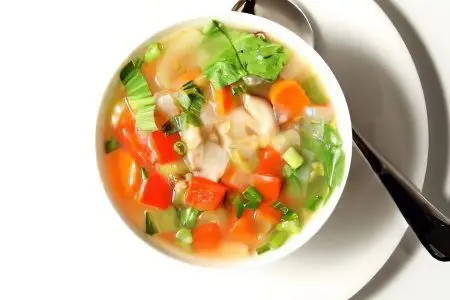Contents
Diet for flatulence is a certain organization of the human diet, which is aimed at reducing gas formation in the intestines. The diet should ensure the full intake of all the substances it needs into the body, contribute to the normalization of intestinal motility, reduce the processes of decay and fermentation in it. The result of the diet is the restoration of normal intestinal microflora and the elimination of a condition such as flatulence.
If we turn to the classification of treatment tables according to Pevzner, then with flatulence it is recommended to stick to table number five. However, the preparation of any diet requires an individual approach and the exclusion of foods that a particular patient cannot tolerate. The energy value of the daily diet for flatulence is somewhat reduced and amounts to 1600 kcal.
Principles of nutrition for flatulence

The principles of nutrition for flatulence are mandatory for their implementation. Otherwise, the diet will not bring the expected benefits.
Rules for eating
Any quick snacks are strictly prohibited. Even if a person intends to eat any fruit, you need to do it in a calm atmosphere, chewing food thoroughly. While eating, you should not carry on a conversation. Thus, it will be possible to exclude aerophagia, and the load on the gastrointestinal tract will be lower.
Do not drink any liquid while eating.
Approaches to the table must be made at the same time. This will enable the gastrointestinal tract to “remember” the hours of food intake and prepare for the process of its digestion and assimilation. Gastric juice, digestive enzymes, bile acids will be released in time.
Chewing gum for flatulence is prohibited. This is due to aerophagia during chewing and an unnecessary increase in gastric juice.
Diet. It is necessary to adhere to fragmentation – eat in small portions, but up to 6 times a day. With this approach, useful substances will be broken down and absorbed in the intestines, and everything else will be quickly excreted without leading to putrefactive processes.
The temperature of the food consumed. Do not eat excessively hot or excessively cold foods. Food must be warm. Thus, it will be possible to avoid excess production of stomach juices, which contributes to intestinal irritation.
Food compatibility. Do not forget that there are products that are mutually exclusive. For example, milk and coarse plant foods, sweet and savory foods. If you do not adhere to the principle of food compatibility, then it will be much more difficult for the intestines to cope with the food lump that has entered it, which means that the risk of starting fermentation processes increases.
Food processing. Products recommended for flatulence should be either steamed, baked, boiled, or stewed. Thus, the principle of sparing the gastrointestinal tract will be observed.
Drinking regimen and salt intake. Salt can irritate the stomach and intestines, so it is somewhat limited in use. The recommended dose of 8 g should not be exceeded. As for the amount of fluid consumed, at least 2000 ml of water should be drunk per day.
What can not be eaten with flatulence?
The list of prohibited products is quite extensive. First of all, this is all the food that contributes to increased gas formation.
There are three such product groups:
Products that contain coarse indigestible fiber. Once in the intestines, such a food lump promotes the growth of microflora. Accordingly, in the course of their life they will release more gases, which will lead to flatulence.
Foods that contain simple carbohydrates. On the contrary, they break down very quickly in the intestines and provoke the processes of putrefaction.
Products to which the patient has an individual intolerance. Most often, people have lactose deficiency, so whole milk and all products containing it should be removed from the menu.
Protein food will contribute to the development of decay processes, as it is quickly broken down in the intestines. Unnecessary irritants include preservatives, food additives, essential oils, organic acids.
So, here’s what you can not eat with flatulence:

Fresh sweet pastries;
Millet bread, rye bread;
Baked pies;
Pasta;
Dumplings and dumplings;
Any fatty meat, including poultry and fish;
Any stringy meat;
Fatty broths;
Pickles and marinades, even homemade, herbs, sauces;
Any canned food;
Salted fish, caviar;
Lard, corned beef;
Smoked products;
Mushrooms, cooked in any form;
Some cereals: barley, millet, barley;
Products containing animal fat: milk, fat sour cream, cream;
Any representatives of legumes: peas, lentils, chickpeas, beans and dishes based on them;
Any cabbage, raw onion, radish, daikon, radish, turnip;
Raisins and prunes;
Some fruits: melons, grapes, pears, apples, peaches, bananas;
Nuts;
Coffee, cocoa with milk;
Drinks containing gases (except for specialized mineral waters on the advice of a doctor);
Beer, kvass, koumiss;
Chocolate, honey, jam;
Potatoes and other products containing a large amount of starch;
Soy products (soy milk, tofu cheese);
Fried and boiled eggs until fully cooked.
What can you eat with flatulence?
Products that are allowed for flatulence are those that do not irritate the intestines, do not stimulate gas formation, and do not have a carminative effect. The food bolus that enters the intestines should slowly and gently pass through it, without lingering and without untying the processes of decay and fermentation.
It is important to include in the dishes those foods that contribute to the growth of normal microflora, are rich in iron, potassium, calcium and vitamins.
So, here’s what you can eat with flatulence:

Rusks made from wheat flour;
Rye bran;
Bread of yesterday’s baking, or dried bread;
Souffle, meatballs, meatballs, meatballs from lean animal meat (veal, rabbit) and poultry (cooking method – steam), the skin must be removed;
Seafood, low-fat boiled fish;
Meat and fish broths;
Fish and meat pates;
Cottage cheese soufflé, low-fat bio-kefir, yogurt, curdled milk and non-fat sour cream (unless lactose intolerant);
Limited: potatoes, beets, carrots, zucchini, pumpkin;
Parsley, dill, you can cook dill water;
Of the seasonings, cumin and bay leaf are allowed;
Cereal porridge cooked on water: oatmeal, semolina, rice and buckwheat;
Soft-boiled eggs, protein steam omelet;
Green tea, cocoa on the water, decoction of wild rose, blueberries, bird cherry, compotes, diluted juices.
In fact, the menu for flatulence only at first glance seems too strict. However, from a set of allowed products, you can cook a considerable number of tasty and healthy dishes against which the intestines will not rebel.
A sample menu for flatulence might look like this:
Breakfast | Lunch | Dinner | Afternoon snack | Dinner | |
First option | Oatmeal. Cocoa on the water | Yesterday’s bread with homemade fish pate or vegetable caviar. | Hake fish soup, chicken meatballs with vegetable stew. Compote. | Baked apple. Ryazhenka. | Cottage cheese casserole. Braised chicken ventricles with rice. Green tea. |
The second option | Cottage cheese pancakes, semolina porridge. Green tea. | Sandwich with cheese. | Vegetable soup. Rabbit meatballs with buckwheat. Rosehip decoction. | Soft-boiled egg. Kefir. | Casserole with potatoes and fish. Steamed squash fritters. Compote. |
Foods that cause flatulence
There are products that cause flatulence when consumed, even in people who do not have problems with the digestive tract, these are:
Any fresh pastries, especially black bread and yeast pastries;
Raw vegetables containing coarse fiber and extractives: cabbage, radish, onion and garlic, turnip, radish, spinach;
Fatty fish, meat, poultry;
Fried foods;
All legumes;
Hard-boiled eggs;
Any smoked dishes;
Nuts;
Barley and millet groats;
Sugar and its substitutes;
Whole milk, heavy cream, ice cream;
Sweet raw fruits: grapes, bananas, apples;
Any carbonated drinks: sweet water, kvass, beer.
In addition, exotic dishes can increase gas formation, as the human digestive system gets used to the breakdown of foods that he eats daily. In this regard, unusual fruits that do not grow in their native climate zone can pose a danger. For example, for Russians, these are pineapples, avocados, kiwi, grapefruits and other exotics.
Useful Tips

It is possible and necessary to fight flatulence caused by malnutrition.
The following helpful tips can help:
It is necessary to divide all meals into 5-6 approaches to the table per day (the principle of fractional nutrition);
Do not drink food with any liquids, including hot tea;
Food and snacks “on the go” are prohibited;
Gum should remain on store shelves and not fall into the mouth of a person suffering from flatulence;
You need to drink as much ordinary clean water as possible;
Be sure to include a hot liquid dish in the daily menu;
During the diet, sorbents or absorbent preparations can be used;
Fruits and juices should not be combined with other foods, they should be consumed as an independent dish.
If you take into account all the recommendations, then flatulence due to malnutrition will not occur. When the diet does not give the desired effect, it is necessary to consult a specialist.









